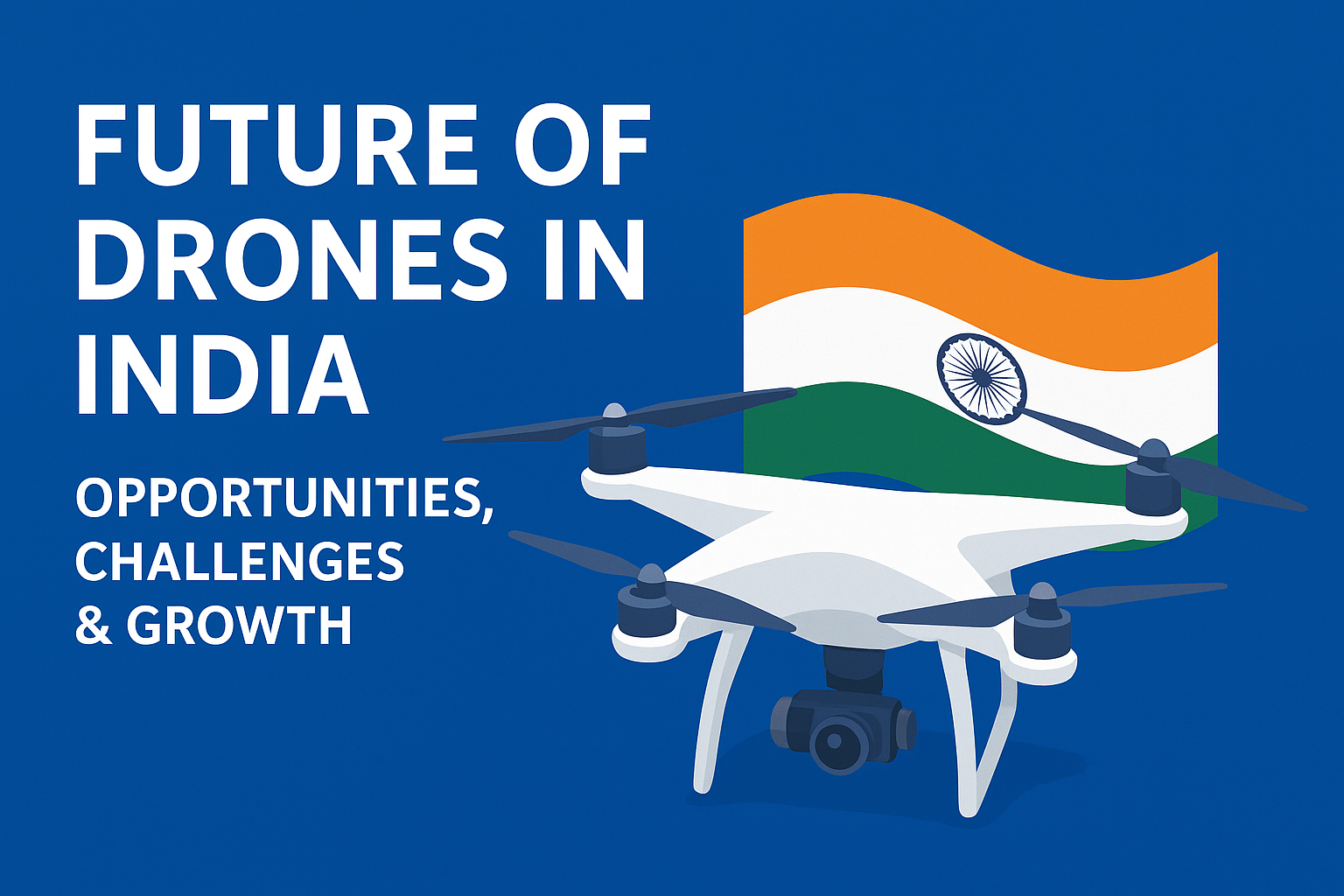Future of Drones in India
Explore how drones are transforming industries like agriculture, defense, logistics, and more in India.

The Future of Drones in India: Opportunities, Challenges, and the Road Ahead
In the last decade, drones have rapidly transformed from being niche gadgets into powerful tools for industries, governments, and individuals. Globally, unmanned aerial vehicles (UAVs) are being embraced for purposes ranging from agriculture and logistics to security and entertainment. India, with its massive population, diverse geography, and booming technology ecosystem, is emerging as one of the most promising markets for drone technology.
As we step into the future, the role of drones in India is expected to grow multifold, reshaping sectors like agriculture, defense, logistics, disaster management, and infrastructure. Let’s explore how drones are poised to shape India’s future, the opportunities they create, the challenges ahead, and what lies on the horizon.
1. Growing Drone Ecosystem in India
India’s drone industry has seen a sharp rise in recent years, particularly after the government introduced the Drone Rules, 2021, which simplified licensing and approvals. The government has also launched the Drone Shakti initiative to encourage drone-as-a-service (DAAS) startups and is promoting the manufacturing of drones under the Make in India campaign.
Several Indian states have already deployed drones for land surveying, agricultural spraying, disaster relief, and even traffic monitoring. Startups like ideaForge, Skylark Drones, and Garuda Aerospace are driving innovation with indigenous solutions tailored for Indian conditions.
2. Key Sectors Where Drones Will Play a Transformative Role
a. Agriculture: From Fields to the Sky
Agriculture employs nearly half of India’s workforce, and drones are set to revolutionize this sector. From spraying pesticides and fertilizers to monitoring crop health through aerial imaging, drones can help farmers save time, cut costs, and increase yields.
The government has already permitted the use of agricultural drones with subsidies, giving a boost to rural adoption. In the future, we can expect precision agriculture powered by drones, where farmers make data-driven decisions about water usage, soil conditions, and pest control.
b. Logistics and Delivery: The Skyway to Faster Commerce
Imagine receiving your groceries or medicines within minutes, delivered by a drone directly to your doorstep. While this might sound futuristic, India is already testing drone delivery in states like Telangana and Karnataka.
E-commerce giants, food delivery apps, and logistics companies are experimenting with drone corridors to overcome traffic bottlenecks in urban areas. In rural and remote regions, drones could be a game-changer by delivering vaccines, medical supplies, and essential items where traditional transport is slow or inaccessible.
c. Defense and Security: Strengthening National Borders
Drones are already part of India’s defense strategy. Surveillance drones are used to monitor borders, track enemy movements, and enhance situational awareness. With increasing geopolitical challenges, the demand for indigenous military drones is expected to surge.
In addition, drones can support disaster management by mapping flood-affected areas, assessing earthquake damage, or helping in search and rescue operations. Law enforcement agencies are also using drones for crowd management and traffic control in major cities.
d. Infrastructure, Mining, and Urban Planning
Infrastructure projects in India often face delays due to surveying and monitoring challenges. Drones can speed up land mapping, construction monitoring, and inspection of bridges, roads, and power lines. In mining, drones can safely survey hazardous areas, reducing risks for workers.
Urban planners can leverage drone data for smart city projects, tracking encroachments, monitoring air pollution, and improving traffic flow systems.
e. Media, Entertainment, and Tourism
The popularity of drone photography and videography has already taken off in India. From weddings and real estate to tourism promotions, drones are redefining visual storytelling. In the future, drones could be used for live event broadcasting, cinematic experiences, and even immersive virtual tourism.
3. Opportunities for India
- Job Creation: With the growing adoption of drones, India is expected to generate thousands of new jobs in manufacturing, operations, maintenance, and drone-pilot training.
- Startup Innovation: India’s young entrepreneur base is exploring drone applications across agriculture, logistics, and AI-driven analytics.
- Make in India Push: By manufacturing drones locally, India can reduce dependence on imports and emerge as a global exporter of cost-effective UAV solutions.
- Global Competitiveness: With its vast geography and diverse challenges, India can become a testing ground for innovative drone applications that can be scaled globally.
4. Challenges Ahead
- Regulatory Hurdles: Despite progressive Drone Rules, obtaining clearances for commercial drone operations can still be complex.
- Privacy and Security: With drones capable of high-resolution surveillance, concerns around privacy and misuse remain critical.
- Infrastructure Readiness: Drone delivery and urban use will require dedicated drone corridors, charging hubs, and traffic management systems in the skies.
- Skilled Workforce: To scale drone adoption, India needs certified drone pilots, engineers, and technicians trained in handling and maintaining UAV systems.
5. The Road Ahead
The future of drones in India is bright and full of possibilities. Here’s what we can expect in the next decade:
- Mainstream Drone Delivery: From medicines to groceries, drone delivery will become part of everyday life, especially in rural areas.
- AI-Powered Drones: Artificial intelligence will enable drones to operate autonomously, analyze data, and make real-time decisions.
- Integration with 5G: With ultra-fast connectivity, drones will be able to transmit real-time video and sensor data, opening new applications in telemedicine, surveillance, and entertainment.
- Public-Private Partnerships: Collaboration between startups, corporates, and government will accelerate drone adoption across sectors.
- Eco-Friendly Solutions: Electric and solar-powered drones will reduce environmental impact, aligning with India’s commitment to sustainability.
Conclusion
India stands at the cusp of a drone revolution. With supportive government policies, a thriving startup ecosystem, and increasing demand across sectors, drones will soon become as common as smartphones. From enhancing food security and healthcare to bolstering national defense and powering e-commerce, drones will touch almost every aspect of life in India.
The coming decade will define how effectively India can harness this technology to boost productivity, ensure safety, and create new opportunities. The future of drones in India is not just about machines flying in the sky — it’s about building smarter, safer, and more connected communities on the ground.


Comments (3)
Great article! The section about performance optimization was particularly helpful for my current project.
Thanks for sharing these insights. Would love to see a follow-up article with more advanced techniques.